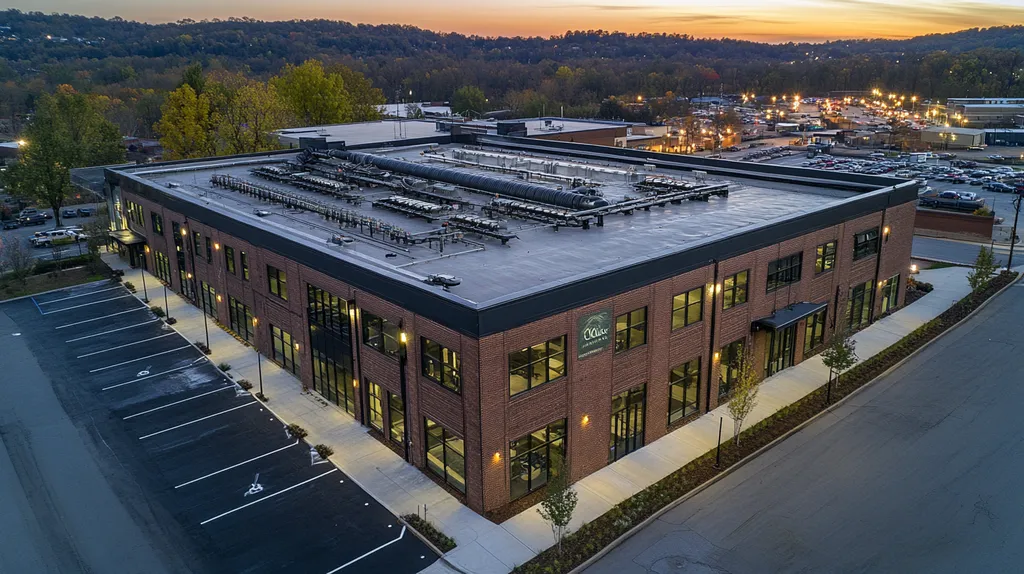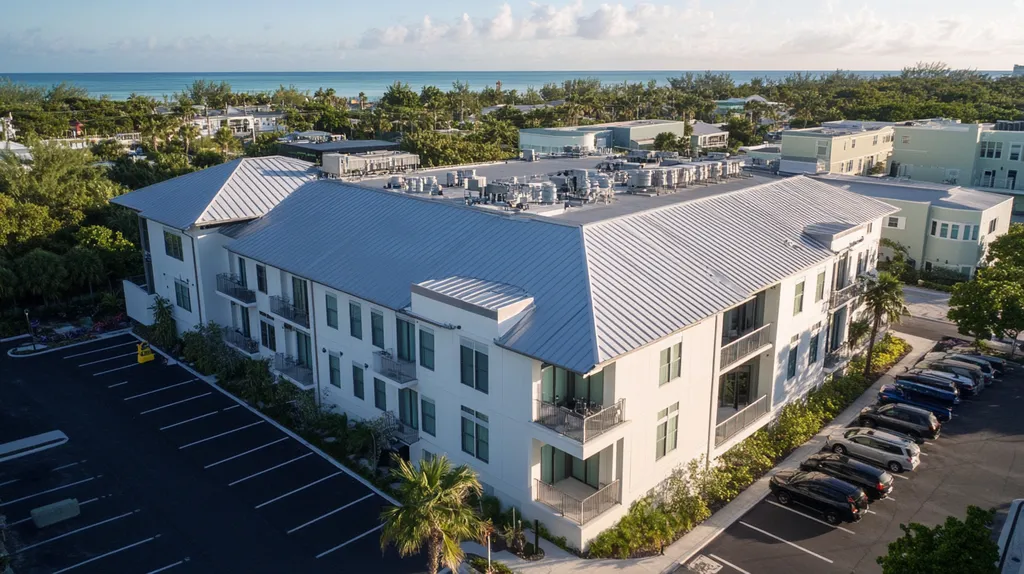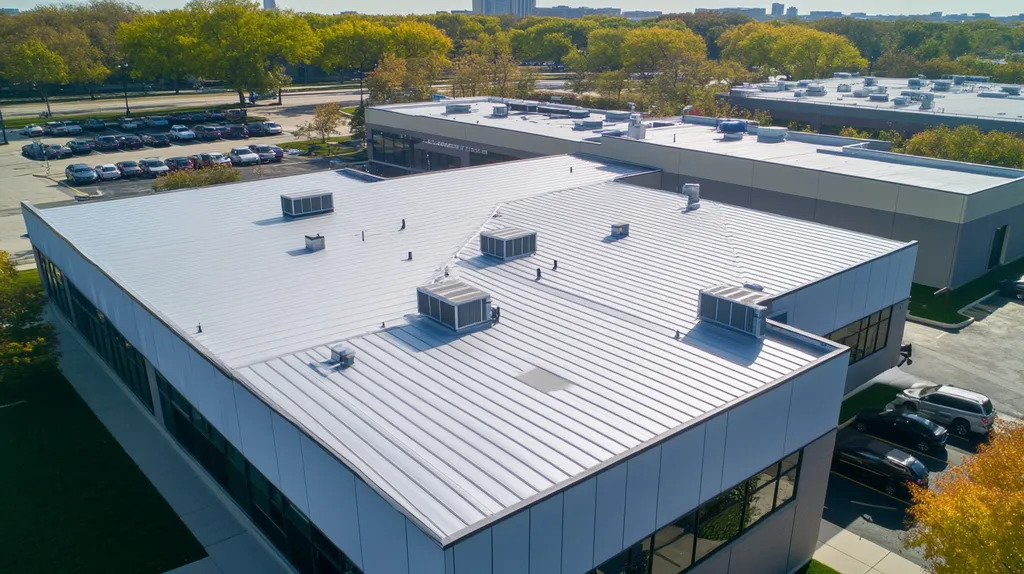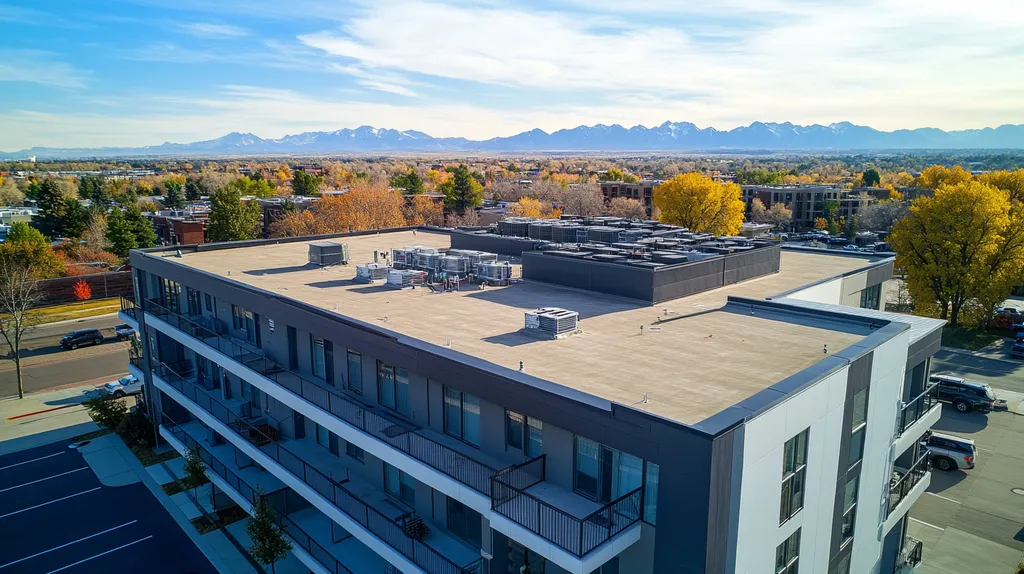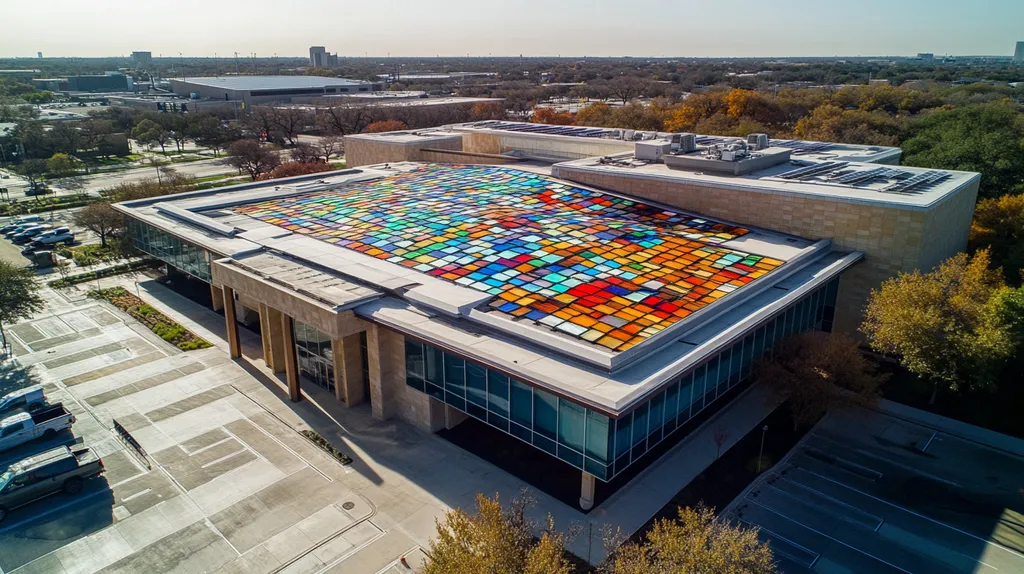Every year, industrial facilities lose millions in revenue due to preventable roof damage, with 90% of these issues traceable to missed early warning signs. From subtle leaks to major structural concerns, regular roof inspections are crucial for protecting valuable assets and operations.
Yet many property owners remain unaware of proper inspection protocols, leading to costly emergency repairs and business disruptions.
This comprehensive guide breaks down the essentials of industrial roof inspections, from basic concepts to advanced maintenance strategies, helping facility managers make informed decisions about their roofing assets.
SECTION 1: THE BASICS EXPLAINED
Industrial roof inspections are not just a routine task; they’re essential for upholding the structure’s resilience and performance. Imagine ignoring a small crack in your car’s windshield—that minor issue could lead to a dangerous shatter. The same goes for roofs! In fact, 80% of roofing failures occur due to a lack of regular maintenance. This section will break down what a roof inspection is, explain why it is crucial for your building’s health, and describe how the process unfolds to keep your investment secure.
What It Is (In Plain Language)
An industrial roof inspection is like a health check-up for your roof. Inspectors conduct a detailed examination to uncover signs of wear, leaks, and structural issues that could pose safety risks. This isn’t merely a quick glance; it involves various tools and methodologies to probe deep into the roof’s condition.
The ultimate goal? Catching minor issues before they snowball into major problems. By taking this proactive route, property owners can prevent unwanted downtime and frighteningly expensive emergency repairs. During the inspection, critical areas—like flashings, seams, and waterproofing—are thoroughly assessed.
Common tools include moisture meters and infrared cameras, which unveil hidden troubles out of sight. Advanced technology greatly enhances the ability to assess the roof’s health comprehensively.
To sum it up, an inspection is more than a quick check; it’s a vital strategy for prolonging the life of your roof. Regular evaluations help maintain an effective roofing system that can brave the elements and safeguard your investment.
Why It Matters (To Your Building)
Regular roof inspections are vital, and their importance cannot be overstated. A well-maintained roof acts as a fortress, protecting the entire structure from water damage, mold infestations, and decay. Ignoring the need for inspections can have dire consequences, leading to extensive and costly repairs.
Consider this: a tiny leak can disrupt insulation and spark energy inefficiency, increasing operating costs and potentially hampering productivity within your facility. According to the National Roofing Contractors Association, preventive maintenance can lower costs by an impressive 50% over time.
Moreover, an inadequate roofing system can put compliance with safety standards at risk. For many industries, maintaining building integrity is not optional; it’s a legal necessity. Non-compliance could lead to fines or shutdowns.
Additionally, a pristine roof can enhance property value. Buyers and tenants are naturally drawn to properties that showcase diligent maintenance, making inspections an indirect investment in the building’s future.
How It Works
The inspection process kicks off with an initial assessment of the roof’s type and materials, helping inspectors decide on the best strategy to evaluate its condition. Both the roof’s interior and exterior are scrutinized.
Inspectors search for visible signs of damage—think cracks, blisters, or missing components—since each of these indicators might hint at a more significant issue lurking beneath. After the inspection, detailed reports highlight the findings and suggest necessary repairs.
Scheduling inspections seasonally or semi-annually, based on local climate, is essential to address any weather-related wear and tear before it transforms into critical problems. State-of-the-art technologies, such as drones, are becoming popular for making inspections safer and more thorough.
Once the inspection is complete, a maintenance plan can be created according to the discovered issues. By prioritizing repairs and regular maintenance, property owners ensure their roofs—and structures—stand the test of time. Regular inspections empower property owners to take command of their roofing assets effectively.
SECTION 2: PRACTICAL APPLICATIONS
Roof inspections are critical to protecting industrial properties from costly issues. Ignoring regular checks can lead to damage that costs property owners thousands in repairs. By catching problems early, you can save energy, extend the life of your roof, and avoid leaks that could disrupt operations. This section delves into the practical applications of roof inspections, highlighting their uses, the best times to conduct them, and their interactions with other building systems.
Common Uses & Examples
Regular roof inspections play a crucial role in maintaining the overall health of industrial roofs. They help detect issues like cracks, punctures, or loose flashing before they turn into significant headaches. For instance, a quick visual check might reveal a debris buildup that could cause water pooling on the roof, increasing the risk of leaks.
In many industrial environments, inspections are integral to a comprehensive maintenance plan. Equipment and machinery need to operate without interruption, and a compromised roof can bring operations to a grinding halt. Proactive inspections ensure that unexpected leaks or structural failures won’t disrupt productivity.
Records from inspections can also be rich sources of information for future planning. Keeping a maintenance log empowers property owners to strategize repairs, replacements, and upgrades intelligently. This foresight supports a robust long-term investment in property value.
If energy efficiency is high on the priority list, inspections take on even greater significance. They can evaluate the condition of insulation and reflective surfaces, pinpointing areas that may lead to sky-high heating and cooling costs. Keeping these aspects in check boosts operational efficiency and saves money.
When You Need It Most
Understanding when to conduct roof inspections is key to maximizing their effectiveness. Seasonal changes can dramatically impact roof conditions. Inspecting before winter allows for the identification of vulnerabilities that could worsen under the weight of snow and ice. Facilities in rainy regions benefit from inspections right before the wet season to address potential drainage challenges.
Major weather events should always prompt immediate inspections. High winds can cause damage that’s difficult to spot from the ground, especially on larger rooftops. Swift identification of these issues can prevent exacerbating risks down the line.
After any significant maintenance or renovations, a thorough inspection is crucial. Changes made during roof work or equipment installations can temporarily affect the roof’s integrity, requiring a careful assessment to confirm everything is secure. This diligence preserves not only investments but also safety.
Moreover, routine inspections should occur at least twice a year, regardless of external conditions. This proactive approach helps identify gradual wear and tear that might otherwise go unnoticed, ensuring your roof remains in prime condition.
Interactions With Other Systems
Your industrial roof doesn’t function in isolation—it interacts with several systems within the facility. For instance, HVAC equipment often sits on rooftops, and improper sealing around these units can lead to leaks. Inspections should carefully evaluate these connections to mitigate moisture buildup that could harm both the roof and the building’s interior.
Drainage systems are another critical component of roof health. Clogged or malfunctioning drains may cause water to pool, jeopardizing the roof’s structural integrity. Inspectors need to assess downspouts, gutters, and drainage channels to ensure they’re operating effectively.
Moreover, electrical and fire suppression systems depend on the roof’s condition too. A compromised roof can hinder these systems, posing safety risks. Inspections should address how the roof’s health affects electrical setups and fire safety protocols, leading to a safer working environment.
Lastly, quality insulation plays a vital role in energy consumption. Regular inspections must evaluate the state of insulation to guarantee it performs as expected. Poor insulation leads to increased energy costs, impacting overall operational efficiency and bottom-line profits, making these evaluations essential for savvy property management.
SECTION 3: KEY TERMINOLOGY DECODED
In the world of roofing, understanding the right terminology is crucial to conducting effective inspections and ensuring long-term maintenance. Misunderstanding crucial terms can lead to hefty surprises down the line regarding budgets and safety. For example, many property owners underestimate the importance of “flashing,” viewing it as a minor detail, when in reality, it plays a pivotal role in leak prevention. This section aims to clarify essential terms and translate industry jargon into everyday language to empower informed decision-making.
Essential Terms Explained
Roofing terminology like “ponding water” and “membrane” might sound complicated, but they are key to understanding roof health. Ponding water refers to the water that lingers on the roof for more than 48 hours, causing potential structural damage, encouraging mold growth, and heightening leak risks.
“Membrane,” on the other hand, denotes the protective layer that shields your roofing system from moisture. There are various types, such as TPO or EPDM, each possessing distinct properties that impact both durability and cost. Familiarizing oneself with these terms sets the stage for effective maintenance strategies and informed budgeting.
Industry Jargon Translated
Navigating the roofing industry’s jargon can sometimes feel like deciphering a secret code. Terms like “drainage slope” and “thermal efficiency” appear frequently but often lead to confusion. Drainage slope refers to the roof’s angle, crucial for directing water to drains instead of letting it pool, where it can create serious problems and escalate repair costs.
“Thermal efficiency” gauges a roof’s ability to retain or repel heat. A roof with poor thermal efficiency can inflate energy bills, impacting overall operations. By demystifying this jargon, property owners and facility managers facilitate clearer discussions with roofing professionals, minimizing the risks of oversight and ensuring projects stay on track.
Measurement & Units Simplified
Accurate measurements are vital for effective roofing inspections, yet they can often feel overwhelming. Common units include square footage for area and inches for slope. Knowing the roof’s area is crucial for estimating both material requirements and associated costs accurately.
The roof slope, typically expressed as a ratio (like 4:12, indicating the roof rises 4 inches over a horizontal run of 12 inches), profoundly affects water drainage and material choice. Misunderstanding these measurements may lead to inappropriate solutions that can jeopardize the roof’s functionality.
By simplifying measurement concepts, property managers can increase inspection accuracy and enhance maintenance planning. Getting these details right not only protects the roof’s integrity but also secures the overall investment in the property.
SECTION 4: DECISION FACTORS
The stakes of industrial roof inspections extend far beyond maintenance; these checks can dramatically influence a property’s operational efficiency and financial health. Shockingly, nearly 70% of commercial building owners in the U.S. underestimate roofing costs, paving the way for unforeseen expenses that can have serious consequences. A careful evaluation of costs, performance, and durability is vital to ensuring long-term protection against potential hazards. This section dives into the essential decision factors that shape roofing choices for industrial properties.
Cost Considerations
When exploring roofing options, grasping both upfront and long-term costs is crucial. A tempting initial investment in cheaper roofing materials or services can prove to be a real headache down the line. For example, while opting for a less expensive single-ply membrane may seem budget-friendly today, it could result in more frequent repairs or replacements later.
Moreover, budgeting for regular maintenance and unexpected repairs is imperative. Skimping on inspection costs can lead to hidden leaks that escalate into significant structural problems. The financial hit from these issues can far outweigh any initial savings that may have come from choosing a lower-quality roof.
It’s also important to consider the costs associated with business interruptions. A leaky roof can grind operations to a halt, adversely affecting revenue and customer satisfaction. By factoring in these elements, property owners can arrive at more informed and financially sound roofing decisions.
In summary, investing wisely in quality roofing can translate into significant savings over time. When costs are evaluated holistically, property owners are better positioned to balance expenditure with performance and reliability.
Performance Trade-offs
Performance is a key player in roofing decisions, with significant trade-offs among different materials and their capabilities. For instance, while traditional asphalt roofs are affordable, they might not withstand extreme weather conditions as effectively as modern materials like thermoplastic polyolefin (TPO).
Understanding the roof’s environment is essential. For industrial properties located in regions prone to high winds or heavy rain, selecting a durable roofing option can minimize damage and reduce the frequency of repairs.
Another vital performance aspect is energy efficiency. Energy-efficient roofing solutions, such as reflective membranes, can drastically cut cooling costs, often helping to recover the initial investment over time.
The key is to find the right balance between durability and performance features. A roof may offer top-notch thermal insulation but have a shorter lifespan, increasing replacement frequency. A comprehensive analysis of all performance factors is essential to align with the unique needs of each industrial property.
Lifespan & Durability Factors
Lifespan and durability are crucial components of any roofing strategy. Investing in a long-lasting roof can spare property managers from the headaches of repeated replacements and continuous maintenance costs. For example, metal roofs can last up to 50 years, while traditional materials might need replacing after just 20.
When evaluating durability, it’s important to remember that different materials handle environmental stresses in unique ways. A roof that endures UV exposure, temperature swings, and moisture will often require less frequent replacement, leading to cost savings.
Also, consider how the roof will adapt to future upgrades or repairs. A roof that accommodates solar panels or other energy-efficient enhancements offers long-term value as energy standards evolve.
Ultimately, understanding the connection between lifespan, durability, and the intended use of the roof is vital. A strategic investment enables enhanced safety and helps lower costs over time, ensuring both the building and its occupants are well protected.
SECTION 5: COMMON CHALLENGES
In the dynamic realm of industrial roofing, neglecting regular inspections can spell disaster. Alarmingly, studies show that around 30% of all roof failures result from overlooked maintenance. Property owners and facility managers must remain alert to common challenges, from spotting damage before it escalates to implementing effective prevention strategies. By understanding these issues, they can mitigate risks and significantly extend their roofing systems’ lifespan.
Frequent Problems & Solutions
Water pooling is a prevalent issue in industrial roofing that can lead to severe leaks and structural damage. When drainage systems become clogged or inefficient, standing water becomes a significant concern. Regular inspections can identify these problems early. By routinely clearing debris from gutters and ensuring the roof has an adequate slope, property managers can effectively reduce this risk.
Membrane punctures are another frequent headache, often resulting from foot traffic or falling debris. These small issues can escalate quickly if left unaddressed. The simple solution? Employ protective walkways and designate specific areas for heavy equipment to minimize strain on the roofing membrane.
Moreover, aging roof seams can crack and separate over time. By ensuring these vulnerable areas are well-sealed during routine inspections, leaks can be prevented. Engaging qualified roofing contractors for timely repairs is crucial to maintaining the roof’s integrity and prolonging its lifespan.
Ultimately, grasping these common roofing mistakes empowers property owners to take proactive measures and seek professional assistance, helping to preserve their investments for the long haul.
Warning Signs To Watch For
Vigilance is key when it comes to spotting early warning signs of roofing issues. One major indicator is stains on interior ceilings or walls, which often signal leaks originating from the roof. Addressing these signs swiftly can prevent more extensive damage and escalating costs.
Blisters or bubbles in roofing materials are another red flag that indicates moisture trapped beneath the surface. This can severely compromise the roof’s effectiveness. Regular visual inspections focused on these areas can prompt timely repairs before issues worsen.
Visible mold or mildew on roofing surfaces or inside buildings is another concerning sign. It not only hints at leaks but can also affect air quality, posing health risks. Keeping an eye on these biological growths can inspire necessary actions to maintain a safe work environment.
Lastly, any sagging or uneven roofing structures could reveal deeper structural problems. Property managers should conduct regular surveys of the roof’s integrity and consult experts as soon as anomalies are detected.
Preventative Approaches
Taking a proactive stance on industrial roof maintenance is crucial to minimizing risk and cutting costs. Establishing a regular inspection schedule, ideally biannually or after significant weather events, helps catch issues before they escalate. Teaming up with a licensed roofing contractor ensures thorough assessments and professional insights.
Incorporating routine maintenance tasks, such as cleaning drainage systems and performing necessary repairs, helps avert deterioration and extends the roof’s life. This proactive approach is far more cost-effective than facing major repairs later on.
Advanced technologies, like infrared thermography, can elevate inspections by revealing hidden moisture that typical visual checks might miss. This method enhances the efficiency of evaluations and allows for targeted repairs.
Lastly, developing a roof-specific emergency response plan can substantially reduce the impact of unforeseen damage. This plan should outline immediate actions, available resources, and contact information for roofing professionals to ensure a swift and effective response.
SECTION 6: NEXT STEPS & RESOURCES
Taking proactive steps to safeguard your roof is essential, as unchecked damage can lead to unexpected and costly repairs. By developing a strategic inspection plan, property owners can save a significant amount on future expenses. Knowing what questions to ask roofing providers, familiarizing oneself with industry standards, and utilizing available educational resources are all critical to maintaining the integrity and longevity of industrial roofs.
Questions To Ask Providers
When reaching out to a roofing provider, start by asking about their inspection process. It’s important to know how often they recommend inspections and whether they employ advanced technologies like thermal imaging. Understanding their thoroughness can provide peace of mind regarding your roof’s assessment.
Additionally, clarify how they document their findings. Detailed reports with photographs and clear action plans for repairs are essential for informed decision-making. Transparent communication ensures that property owners are kept in the loop.
Don’t forget to inquire about their experience with materials specific to your roof type. An expert who understands the unique challenges of industrial roofs will navigate solutions far more effectively.
Finally, check that they comply with local codes and industry standards. This adherence emphasizes a commitment to quality and safety, which are non-negotiable when it comes to roof maintenance.
Industry Standards & Guidelines
Being aware of industry standards is key to effective roof maintenance. The National Roofing Contractors Association (NRCA) offers guidelines that delineate best practices for inspections and maintenance, ensuring roofs receive a high standard of care.
The American Society for Testing and Materials (ASTM) outlines essential testing methods for roofing materials, helping to determine their suitability and expected lifespan. Following these guidelines protects your investment and compliance.
Don’t forget to consult local building codes as they provide specific requirements necessary for roofing in your area. Adhering to these regulations ensures safety and functionality throughout the roofing system.
Lastly, organizations like the Roofing Industry Alliance for Progress offer valuable research and insights to guide your roofing decisions. Staying updated through these resources can greatly enhance your roof’s longevity and effectiveness.
Further Learning Simplified
For ongoing education in roofing, engaging in webinars and workshops offered by industry associations is a smart choice. These programs can introduce you to the latest trends and technological advancements in roofing.
Online resources, such as the International Institute of Building Enclosure Consultants (IIBEC), provide a wealth of information, including best practices and inspection guidance, to bolster your knowledge.
Subscribing to industry publications and newsletters keeps property owners informed about new developments and regulatory changes that can impact roofing strategies.
Lastly, hiring a professional consultant can provide tailored insights and training specific to your facility’s roof, making continued education an investment in empowering decision-making for the future.
The Bottom Line
With over 40% of industrial roof failures traced directly to inadequate inspections, the stakes couldn’t be higher for property owners and facility managers.
Regular, professional roof inspections serve as the cornerstone of effective building maintenance, potentially saving organizations tens of thousands in emergency repairs and operational disruptions.
The key is implementing a systematic approach: scheduling bi-annual inspections, documenting all findings, and addressing issues promptly before they escalate into major problems.
By staying vigilant with inspections, using advanced diagnostic tools, and partnering with qualified professionals, facility managers can extend their roof’s lifespan by up to 50% while protecting valuable assets and operations beneath.
The choice is clear: invest in prevention now or pay substantially more for repairs later.
FREQUENTLY ASKED QUESTIONS
Q. What is an industrial roof inspection?
A. An industrial roof inspection is like a health check-up for your roof. Inspectors examine it thoroughly to uncover signs of wear, leaks, and structural risks, using tools like moisture meters and infrared cameras. This proactive approach catches minor issues before they escalate, ensuring your roof remains a strong protector of your investment.
Q. When should I schedule inspections for my commercial roof?
A. It’s best to schedule inspections seasonally or semi-annually based on your local climate. Ideally, conduct a check before winter and rainy seasons to address vulnerabilities, and after significant weather events. Regular inspections help keep your roof in prime condition and prevent critical problems down the line.
Q. What are common terms I should know about industrial roofs?
A. Key terms like “ponding water” and “membrane” are essential in roofing. Ponding water is water that lasts on the roof for over 48 hours, indicating potential issues. Membrane refers to the protective layer that safeguards the roof system. Understanding these terms aids maintenance and decision-making regarding your roof.
Q. How do roofing costs impact my industrial roof choice?
A. The initial costs and long-term expenses of roofing decisions are crucial. Choosing cheaper materials may save money now, but lead to frequent repairs later. Additionally, factoring in business interruption costs and maintenance can provide a clearer financial picture. Wise investments in quality roofs save money over time.
Q. What challenges do I face with my commercial roof?
A. Common challenges include water pooling, membrane punctures, and aging seams, which can lead to leaks and damage. Regular inspections help identify these issues early, allowing for timely repairs. Keeping an eye on potential problems empowers property owners to take proactive measures to protect their investments.
Q. What should I ask roofing providers during consultations?
A. Ask about their inspection process, technology use, documentation practices, and experiences with your roof type. Understanding their approach can help ensure your roof receives a thorough assessment. Inquire about compliance with local codes and industry standards to ensure quality and safety in your roof maintenance.
Q. What resources are available for learning about roof maintenance?
A. Take advantage of webinars, workshops, and online resources provided by industry organizations. Keeping up with magazines and newsletters related to roofing can help you stay informed. Hiring a consultant can also provide tailored insights specific to your facility, enhancing your knowledge and maintenance strategies.

